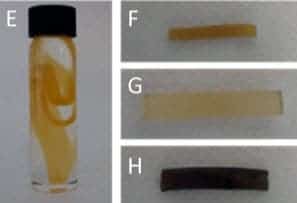Graphene, the wonder material shows its potential once again: now, using graphene and rubber bands, engineers have created a flexible sensor which has significant medical value and can be made cheaply.

Applications of G-bands as body monitors (left to right: finger, wrist, throat) (credit: Conor S. Boland et al./ACS NANO)
You really should know about graphene by now – we’ve written dozens of articles about it just in the past couple of years; but if you don’t, here’s your get out of jail card: graphene is pure carbon in the form of a very thin, nearly transparent sheet, just 1 atom thick. It’s so thin, that for practical purposes, you can almost consider it a 2D material. Now, there’s a lot of hype around graphene, and for good reason: it has some amazing properties. It is the world’s most powerful material, it has unlimited heat conductivity, it repairs itself naturally, it can be made magnetic and turned on and off, it’s incredibly light, it’s a fantastic radio wave absorber, and many, many more. The possibilities of what you can do with it are endless, and we’re just starting to scratch that surface. Making graphene sensors is not entirely a novel idea, but researchers from the University of Surrey and Trinity College Dublin have, for the first time, actually created medical sensors with graphene.

(E) Rubber band soaking in toluene. (F) An untreated rubber band. (G) a band section after soaking in toluene for 3.5 hours. (H) A graphene-infused band prepared by swelling in toluene then soaking in an N-methyl-pyrrolidone-water-graphene mixture for 4 hours followed by washing and drying. (Credit: Conor S. Boland et al./ACS NANO)
They take the rubber band, and apply graphene to it. After the treatment, the band stays flexible, but it can also be used as a sensor to track a patient’s breathing, heart rate, or movement, alerting doctors to any irregularities; and for the patient, there’s no difference whatsoever. You can’t actually feel the 1-atom thick sheet of carbon on the rubber band. Even today, this makes then incredibly cheap compared to alternatives, but as graphene production grows and becomes more cost effective, G-bands (as they’re called) would also become even cheaper.
The researchers, Alan Dalton from the University of Surrey and Jonathan Coleman from Trinity College believe that G-bands could actually revolutionize health monitoring:
“Each device would probably cost pennies instead of pounds, making it ideal technology for use in developing countries where there are not enough medically trained staff to effectively monitor and treat patients quickly,” said Coleman.
Monitoring a human body is not exactly an easy feat; you need to follow position, velocity and acceleration. Sensors have to be cheap, resilient, lightweight, and efficient in order to be usable. Making a sensor that is an order of measure cheaper but still has the same characteristics could be indeed a huge breakthrough. Personally – I hope G-bands become a thing.
Journal Reference: Conor S. Boland et al., Sensitive, High-Strain, High-Rate Bodily Motion Sensors Based on Graphene–Rubber Composites, ACS Nano, 2014, DOI: 10.1021/nn503454h









